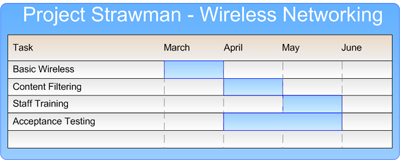Project Planning: Create the Project Plan
The project plan is the blueprint for the remainder of your project. It will provide a guidepost for you and your team to ensure you are on the right path as you get busy with smaller tasks. Every successful project I have lead in the past has had a basic project plan. Those projects that lacked a project plan eventually failed. Let’s find out how to build a simple plan that won’t take too much time to build yet will make your project execute smoothly.
Writing the Project Plan
Document your big idea, milestones, assumptions, and tasks into the project plan. This plan will be shared with each member of your team, along with other teams and your staff to show your overall direction of your project. It should be used constantly throughout the project as a guide of overall progress and to check your assumptions made at the start of the project.
Keep these tips in mind as you develop your project plan:
- Keep it simple – don’t get too detailed too early
- Think it through – make sure you cover all of the high-level details that you and others will need to know (including assumptions you are making or things you don’t know yet)
- Review it with others – select 1-3 other people disconnected from the project and see if they can understand your project. If not, you may be missing some key milestones, tasks, assumptions, or need to clarify your big idea
Add the Project Strawman
Next, consider building a simple project strawman, which is just a guess at the timeline of your project. Below is an example of a strawman project using a Gantt chart format:
A project strawman is a good idea when you need to make a project proposal, or give other leaders and staff an idea of your project’s overall timeline. Anyone viewing the timeline should be told that it is only an estimate and not to be used as a specific timeline, but it should provide a basic indicator about how long you think the project will take and when each milestone will be achieved.
Keep Your Plan Updated
Your project plan should be treated as a living, breathing guide for your project rather than a one-time thing. If necessary, keep older versions of the plan for comparison, but always keep it updated with new milestone dates, new assumptions, etc. The best way to remind yourself, and your team, of the plan is to keep it posted somewhere within easy review.
One final word about project plans: it is easy to allow a plan to drive your life, rather than organize it. Allow your project to take shape over time as you learn things rather than letting your project plan lead you. As your project progresses, it will become more accurate (and likely more realistic).
Have a project plan that worked for you? Share a link in the comments or drop me a note – I’d love to hear from you!
Popularity: 12% []

